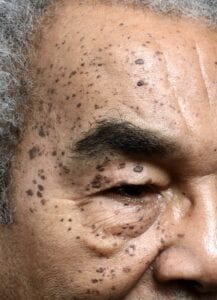Medically known as Dermatosis Papulosa Nigra (DPN), this skin condition looks like little black bumps on the face and neck.
The cause of DPN is still unknown. It is believed to be a congenital anomaly of the skin caused by a hair follicle’s developmental defect. Some medical professionals speculate that it is due to photoaging, while other researchers believe it is a combination of sun exposure and heredity. Around 50% of patients seeking treatment have a family history of the skin condition—a parent or grandparent, for example, might have them. These typically begin during the teen years, and they may increase in number and size as a person ages.
DPN doesn’t require medical treatment – it actually is considered more of a cosmetic concern than anything. While these are benign growths, if you are not sure that a lesion that has developed is dermatosis papulosa nigra, you should check with a dermatologist to make sure it isn’t a serious or cancerous growth.
Once this is ruled out, some very effective, simple treatments are available to get rid of these pesky little skin growths… Two methods use electric current to destroy and remove DPN: electrocautery and electrodesiccation. With electrocautery (or thermal cautery), electric current runs through a small probe with a fine needle electrode tip to cauterize (burn or destroy) skin tissue. In electrocautery, the tip becomes hot, but the current doesn’t pass through the patient.
Electrodesiccation is a specific type of electrosurgery (also called fulguration) and dehydrates and destroys superficial tissue. The electrode remains cool, and the electrical current passes through the tissue. Without touching the surrounding skin, the lesions are desiccated using an instrument with an electrical needle-like tip until the lesions turn a grayish color. An application of a topical anesthetic prior to the procedure will make it more comfortable. At low settings, these are considered safe and effective procedures with minimal to no scarring. I do this treatment in my skincare clinic a lot and highly recommend electrodesiccation treatments for this condition. The best ingredients to use on the skin to support healing the skin after treatment and help prevent scarring and discoloration include serums and balms containing comfrey, calendula, aloe, essential fatty acids, and colloidal silver are very healing post-procedure and will minimize discoloration from these treatments.
Rapid Repair Fluid is THE go-to skin serum for quick recovery and daily use to keep the skin clear. Apply sunblock whenever you are in sunlight. If the face and cheeks have been treated, do not apply makeup, including blush, to the area for three to four days after treatment.

